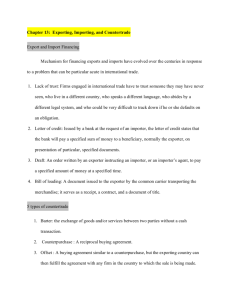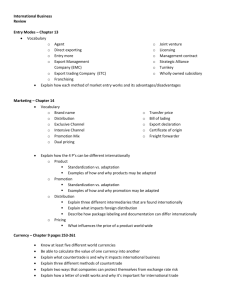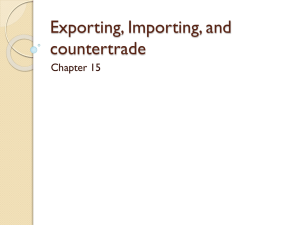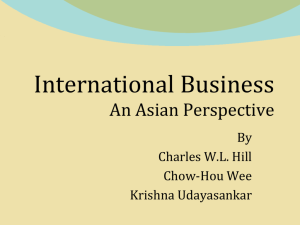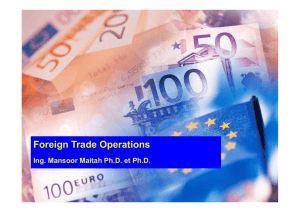Exporting, Importing and Countertrade
advertisement
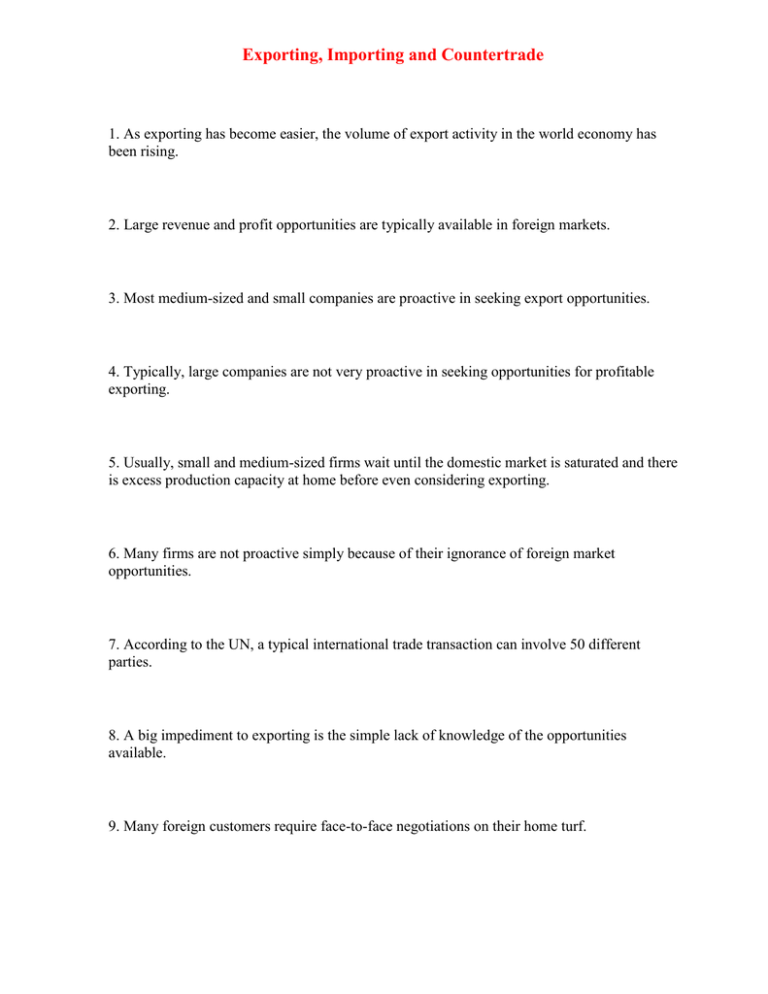
Exporting, Importing and Countertrade 1. As exporting has become easier, the volume of export activity in the world economy has been rising. 2. Large revenue and profit opportunities are typically available in foreign markets. 3. Most medium-sized and small companies are proactive in seeking export opportunities. 4. Typically, large companies are not very proactive in seeking opportunities for profitable exporting. 5. Usually, small and medium-sized firms wait until the domestic market is saturated and there is excess production capacity at home before even considering exporting. 6. Many firms are not proactive simply because of their ignorance of foreign market opportunities. 7. According to the UN, a typical international trade transaction can involve 50 different parties. 8. A big impediment to exporting is the simple lack of knowledge of the opportunities available. 9. Many foreign customers require face-to-face negotiations on their home turf. 10. Unlike their American and Japanese counterparts, German firms are at a disadvantage when it comes to assistance in seeking export opportunities. 11. For American companies, the most comprehensive source of export information is the local government trade department. 12. U.S. firms interested in exporting can acquire a "best prospects" list of opportunities from the U.S. Department of Commerce and its district offices all over the country. 13. The Small Business Administration is a good source of export assistance. 14. An export management company is an export specialist who acts as the export marketing department or international department for their client firms. 15. EMCs are experienced specialists who can help the neophyte exporter avoid common pitfalls. 16. To export successfully, it often makes sense to focus initially on a handful of markets. 17. Entering a foreign market on a large scale provides the opportunity to learn about the foreign country. 18. Exporting is often an end in itself. 19. The least risky method of payment for an exporter involves a confirmed letter of credit and draft in the exporter's currency. 20. For the importer, the preferred method of payment is a time draft. 21. The letter of credit system has evolved to create a less risky environment for international trade. 22. The sight draft specifies that the bank will pay a specified sum of money to the exporter upon the presentation of specified documents. 23. The letter of credit system effectively transfers the issue of trust to the bank. 24. International transactions are usually settled using drafts. 25. Because of the lack of trust in international transactions, payment or a formal promise to pay is required before the buyer can obtain the merchandise. 26. Time drafts are negotiable instruments. 27. Once a time draft is stamped with an acceptance, the maker can sell the draft at a premium to its face value. 28. The bill of lading acts as a receipt, a contract, and a document of title. 29. The bill of lading can act as collateral against which the exporter can draw funds. 30. The mission of the Eximbank is to provide financing aid that will facilitate exports, imports, and the exchange of commodities between the U.S. and other countries. 31. The Eximbank is a part of the WTO's efforts to facilitate trade between nations. 32. American exporters can minimize their risk by purchasing insurance from the Foreign Credit Insurance Association. 33. When conventional means of payment are difficult, a firm might turn to countertrade as a means of structuring an international sale. 34. Firms use countertrade to trade goods and services for other goods and services when they cannot be traded for money. 35. Between 8 and 10 percent of world trade by value is in the form of countertrade. 36. Barter is the simplest form of countertrade. 37. An offset agreement occurs when a firm agrees to purchase a certain amount of materials back from a country to which a sale is made. 38. Switch trading is the direct exchange of goods and/or services between parties without a cash transaction. 39. Countertrade contracts may involve the exchange of poor-quality goods that the firm cannot dispose of profitably. 40. Unless there is no alternative, large, diverse multinational enterprises should probably try to avoid countertrade deals. Multiple Choice Questions 41. Which of the following is of exporting? A. It helps firm achieve economies of scale B. It creates diseconomies of scale C. It increases unit costs D. It creates diseconomies of scope 42. In terms of seeking export opportunities, studies have shown that A. Almost all small firms tend to be proactive about seeking profitable export opportunities B. Most large firms tend to be reactive about seeking export opportunities C. Most small firms systematically scan foreign markets to see where the opportunities lie D. Many medium-sized and small firms are very reactive 43. Which of the following is of reactive firms? A. They may not even consider exporting until their domestic market is saturated B. They create excess productive capacity and actively hunt for opportunities in foreign markets C. Almost all large firms fall under this category D. They systematically scan foreign markets for profitable export opportunities 44. Which of the following helps explain why exporters still account for only a tiny percentage of U.S. firms? A. Lack of export opportunities; buoyant demand within U.S B. Tariffs; FDI restrictions C. Unfamiliarity; intimidation by the complexities D. Regulatory burden; barriers to free trade 45. Japanese exporters get assistance in identifying export opportunities from A. MITI B. The Japanese Outreach Program C. Guanxi D. Chaebol 46. Great trading houses in Japan are called A. Kaizen B. Sogo shosha C. MITI D. Gaunxi 47. Unlike their German and Japanese competitors, U.S. firms are _____ when they see export opportunities. A. Information-disadvantaged B. Money-strapped C. Regulation-bound D. Much better prepared 48. In terms of international comparisons, which of the following statements is ? A. Japanese firms can draw on the large reservoirs of experience of its export-oriented institutions B. The United States has been a relatively self-contained continental economy until recently C. Many German firms are relatively blind when they seek export opportunities D. Japan has long made its living as a trading nation 49. For U.S. firms, the most comprehensive source of export opportunities information is the A. Small Business Administration B. U.S. Department of Commerce C. Federal Trade Commission D. Foreign embassy 50. The U.S. Department of Commerce agencies provides the potential exporter with all of these services except A. Matchmaker programs B. Trade events and exhibitions C. Best prospects lists D. Export subsidies 51. A "best prospects" list A. Gives the names and addresses of potential distributors in the domestic market B. Is provided by the United States and Foreign Commercial Service Agency C. Can provide a firm free, customized market research survey on any product D. Provides information gathering, technical assistance, and export subsidies 52. A "comparison shopping service" A. Provides information only on services B. Is held regularly in major cities worldwide C. Provides names of potential sales representatives D. Has been assembled by the Department of Commerce for 40 countries 53. The Department of Commerce has a _____ program, in which department representatives accompany groups of U.S. businesspeople abroad to meet with qualified agents, distributors, and customers. A. Best prospects B. Matchmaker C. Trade events D. Comparison shopping 54. Which of the following statements about the SBA is ? A. It is the most comprehensive source of export opportunities information B. It employs 10 regional international trade officers throughout the United States C. It employs a 10-person international trade staff in Washington, D.C D. It oversees some 850 volunteers to provide one-on-one counseling to active and new-to-export businesses 55. This is a nationwide group of international trade attorneys who provide free initial consultations to small businesses on export-related matters. A. EMC B. SBA C. ELAN D. SCORE 56. Through its _____ program, the SBA oversees some 850 volunteers with international trade experience to provide one-on-one counseling to active and new-to-export businesses. A. EMC B. SCORE C. ELAN D. L/C 57. EMCs A. Are import legal assistance specialists B. Act as the export marketing department for their client firms C. Serve as the national department for their buyer firms D. Normally accept one type of export assignment 58. _____ is an export specialist who acts as the export marketing department or international department for its client firm. A. An Eximbank B. An import trading company C. A sogo shosha D. An export management company 59. In theory, the advantage of EMCs is that they A. Provide export subsides to the exporting firms B. Are not-for-profit organizations, hence provide free service C. Are subsidized by the Department of Commerce D. Are experienced specialists who can help the neophyte exporter 60. One drawback of relying on EMCs is that A. They are not conversant with the ins and outs of the exporting process B. They have no knowledge of different business mores C. The company can fail to develop its own exporting capabilities D. The company is unable to avoid common pitfalls 61. A firm can increase the probability of exporting successfully by taking which of these steps? A. Avoiding hiring EMCs to lower head counts B. Hiring only home country personnel to build commitment C. Entering on a small scale D. Waiting for the export opportunities to come 62. A key challenge facing export and import financing is A. Limited market opportunities B. Lack of export assistance C. Lack of qualified EMCs D. The lack of trust 63. Which of the following statements about exporting is ? A. A firm needs to be proactive about seeking export opportunities B. Exporting is almost always an end in itself C. It is important for the exporter to retain the option of local production D. Localization can lead to greater market acceptance 64. Which of the following states that the bank will pay a specified sum of money to a beneficiary on presentation of particular, specified documents? A. A draft B. A bill of lading C. A letter of credit D. A promissory note 65. A draft A. Is a document requesting payment B. Is to the same as a letter of credit C. Is a reciprocal buying agreement D. Gives title to shipped goods 66. In a letter of credit transaction, the importer secures the letter of credit A. Before product shipment B. After product shipment C. From the exporter's bank D. After receiving the product 67. In a letter of credit transaction, the exporter ships the product A. After the letter of credit is issued B. Before the letter of credit is issued C. Upon receipt of payment D. With the bill of lading 68. In a letter of credit transaction, the exporter receives its payment from A. The importer B. The importer's bank C. The exporter's bank D. The government 69. What is the biggest advantage of using a letter of credit system? A. The exporter is guaranteed pre-export financing B. It allows the importer time to resell the merchandise before requiring payment C. The trust established, for the importer and exporter, because of a reputable bank D. It guarantees the importer extra funds for other purposes 70. What is the drawback of using a letter of credit system? A. The exporter is no longer entitled to preexport financing B. The importer no longer trusts the exporter C. The exporter is not guaranteed any payment D. The importer must pay the bank a fee for the letter of credit 71. A draft is also known as a A. Bill of attainder B. Bill of exchange C. Bill of lading D. Bill of sale 72. The person or business initiating a draft is known as the A. Beneficiary B. Drawee C. Maker D. Trustor 73. A _____ is payable on presentation to the drawee. A. Time draft B. Bill of lading C. Sight draft D. Trade acceptance 74. A _____ allows for a delay in payment. A. Bill of lading B. Time draft C. Banker's acceptance D. Sight draft 75. A banker's acceptance A. Is payable immediately on presentation to the drawee B. Allows a buyer possession of the merchandise without signing a formal document C. Is a time draft that has been drawn on and accepted by a bank D. Is the same as a sight draft 76. The bill of lading serves all of the following purposes except A. It is a receipt B. It is a bank note C. It is a contract D. It is a document of title 77. A bill of lading A. Is the same as a letter of credit B. Is received from the importer prior to product shipment C. Is a financial note issued by a bank D. Gives title to the goods 78. All of the following are of the Export-Import Bank except A. It provides total coverage against political risks B. It is an independent agency of the U.S. government C. It is also known as Eximbank D. It has a direct lending operation 79. _____ involves trading goods and services for other goods and services when they cannot be traded for money. A. Countertrade B. Forfeiting C. A sight draft D. A time draft 80. When conventional means of payment are difficult, costly, or nonexistent, a firm is more likely to use A. A letter of credit B. A time draft C. Countertrade D. A sight draft 81. The most restrictive form of countertrade is A. Switch trading B. Barter C. Buyback D. Counterpurchase 82. Asian firms that did not have access to export credits to finance their international trade after the1997 crisis turned to A. U.S. backed loan payments B. Foreign direct investment C. Countertrade D. Domestic market expansion 83. When one party agrees to purchase goods and services with a specified percentage of the proceeds from the original sale, and it can fulfill the obligation with any firm in the country to which the sale is being made, it is a(n) A. Barter B. Counterpurchase C. Offset D. Buyback 84. A firm that uses a specialized third-party trading house in a countertrade arrangement is involved in A. A barter B. A counterpurchase C. An offset D. Switch trading 85. When a firm builds a plant in a country and agrees to take a certain percentage of the plant's output as a partial payment for the contract, the firm is involved in a(n) _____ arrangement. A. Counterpurchase B. Buyback C. Switch trading D. Offset Essay Questions 86. Discuss the growth of exporting. What are the factors contributing to the growth pattern? The volume of export activity in the world economy is increasing as exporting has become easier. The decline in trade barriers brought about by the GATT and the WTO along with the move toward regional economic integration have significantly increased export opportunities. In addition, modern communication and transportation technologies have alleviated logistical problems associated with exporting. 87. Why do so many firms take a reactive approach to exporting rather than a proactive approach? There are several reasons why firms do not take a proactive approach to seeking export opportunities. One reason is that most firms are unfamiliar with foreign market opportunities, they do not realize how big the potential market is, or where the opportunities are. A second reason why firms take a reactive approach to exporting is because they are intimidated by the complexities and mechanics of exporting to countries where business practices, language, culture, legal systems, and currency are very different from the home market. A third reason for firms not being proactive about exporting is the number of problems neophyte exporters typically face when trying to do business abroad. 88. What are the typical problems challenging novice exporters when trying to export? Novice exporters run into significant problems when first trying to do business abroad. Typically, this sours the companies on future export opportunities. Common pitfalls include poor market analysis, a poor understanding of competitive conditions in the foreign market, a failure to customize the product offering to the needs of foreign customers, lack of an effective distribution program, a poorly executed promotional campaign in the foreign market, and problems securing financing. Furthermore, novice exporters tend to underestimate the time and expertise needed to cultivate business in foreign countries. Few realize the amount of management resources that have to be dedicated to this activity. 89. Compare and contrast the export assistance provided to German and Japanese companies with that given to American companies. Discuss the implications of the differences between the countries. Germany, one of the world's most successful exporting nations, provides assistance through governments agencies, trade associations, and commercial banks to firms seeking export opportunities. In Japan, similar assistance is provided by the Japanese Ministry of Trade and Industry. In addition, many Japanese firms are associated with the sogo shosha, Japan's great trading houses. The sogo shosha have offices all over the world, and they proactively and continuously seek export opportunities for their companies. In contrast, many American firms are relatively blind when they seek export opportunities because they are information disadvantaged. Consequently, because an institutional structure for promoting exports has yet to evolve in the U.S., American firms are at a competitive disadvantage compared to their German and Japanese counterparts. 90. What information sources are available to American companies seeking information about export opportunities? There are several sources of information available to American companies looking for export assistance. The most comprehensive source of information is the U.S. Department of Commerce. Within the Department of Commerce, there are two organizations dedicated to providing businesses with intelligence and assistance for attacking foreign markets: the International Trade Administration and the United States and Foreign Commercial Service Agency. These agencies provide the potential exporter with a "best prospects" list, which gives the names and addresses of potential distributors in foreign markets along with the businesses they are in, the products they handle, and their contact person. The Department of Commerce has assembled a "comparison shopping service" where companies can receive a customized market research survey on a product. The survey provides information on marketability, the competition, comparative prices, distribution channels, and names of potential sales representatives. The Small Business Administration is also a source of information for exporters, providing counseling and legal assistance. Finally, most states have active trade commissions that can be a source of information. 91. What is an export management company? What are the advantages and disadvantages associated with it? An export management company is an export specialist who acts as the expert marketing department or international department for its client firms. An export management company can help new exporters identify opportunities and avoid common pitfalls. However, the quality of export management companies varies. Furthermore, relying on an export management company prevents the firm from developing its own exporting capabilities. 92. Describe the process involved in financing imports and exports using a letter of credit. Why has this system developed? What is the advantage of using this system? The letter of credit is at the center of international commercial transactions. A letter of credit is issued by a bank at the request of an importer. The letter of credit states the bank will pay a specified sum of money to a beneficiary, normally the exporter, on presentation of particular, specified documents. The advantage of the system is that it introduces an element of trust into the relationship in that both the importer and the exporter are likely to trust reputable banks even if they do not trust each other. 93. Compare and contrast time drafts and sight drafts. Drafts, also known as bills of exchange, are the instruments typically used to effect payment in international trade. There are two types of drafts, sight drafts and time drafts. The sight draft is payable on presentation to the drawee. A time draft allows for a delay in payment - normally30, 60, 90, or 120 days. It is presented to the drawee, who signifies acceptance of it by writing or stamping a notice of acceptance on its face. Once accepted, the time draft becomes a promise to pay by the accepting party. Time drafts are negotiable instruments; that is, once the draft is stamped with an acceptance, the maker can sell the draft to an investor at a discount from its face value. 94. Describe the three purposes of a bill of lading. The bill of lading is an important document for financing international trade. The bill of lading is issued to the exporter by the common carrier transporting the merchandise. It serves three purposes: it is a receipt, a contract, and a document of title. As a receipt, the bill of lading indicates that the carrier has received the merchandise described on the face of the document. As a contract, it specifies that the carrier is obligated to provide a transportation service in return for a certain charge. As a document of title, it can be used to obtain payment or a written promise of payment before the merchandise is released to the importer. The bill of lading can also function as collateral against which funds may be drawn by the exporter to its local bank before or during shipment and before final payment by the importer. 95. Discuss the Exim Bank, its goals, and its operations. The Exim Bank, otherwise known as the Export-Import Bank, is an independent agency of the U.S. government. Its mission is to provide financing aid that will facilitate exports, imports, and the exchange of commodities between the U.S. and the rest of the world. The bank pursues its mission through various loan and loan-guarantee programs. The agency guarantees repayment of medium and long-term loans U.S. commercial banks make to foreign borrowers for purchasing U.S. exports. It also guarantees to make the commercial banks more willing to lend cash to foreign enterprises. Eximbank also has a direct lending operation under which it lends dollars to foreign borrowers for use in purchasing U.S. exports. It grants loans that commercial banks would not if it sees a potential benefit to the U.S. in doing so. The foreign borrowers use the loans to pay U.S. suppliers and repay the loan to Eximbank with interest. 96. What is the Foreign Credit Insurance Association? The Foreign Credit Insurance Association (FCIA) is an association of private commercial institutions operating under the guidance of the Export-Import Bank to provide export credit insurance. The FCIA provides coverage against commercial risks and political risks. Losses due to commercial risk result from the buyer's insolvency or payment default. Political losses arise from actions of governments that are beyond the control of either buyer or seller. 97. Explain what is meant by countertrade. What is the purpose of countertrade? When conventional means of payment are difficult, costly, or nonexistent, firms may turn to countertrade as an alternative means of structuring an international sale. Countertrade denotes a whole range of barter-like agreements; its principle is to trade goods and services for other goods and services when they cannot be traded for money. Countertrade can be used when a government restricts the convertibility of its currency to preserve its foreign exchange reserves so they can be used to service international debt commitments and purchase crucial imports. 98. Consider the incidence of countertrade. Where is it most common? Countertrade became popular in the1960s as a way for the Soviet Union and the Communist states of Eastern Europe, whose currencies were generally nonconvertible, to purchase imports. During the1980s, the practice became popular in many developing nations that lacked the foreign exchange to purchase necessary imports. Estimates of the percentage of world trade covered by some sort of countertrade agreement range from highs of 8 and 10 percent by value to lows of around 2 percent. In the tight monetary regime that followed the crisis in 1997, many Asian firms found it very difficult to get access to export credits to finance their own international trade. Thus they turned to the only option available to them—countertrade. 99. What is the simplest form of countertrade? Why are firms reluctant to engage in this type of arrangement? The simplest form of countertrade is barter. Barter is the direct exchange of goods and/or services between two parties without a cash transition. Barter is not common because of the challenges it presents to the parties involved. In particular, if goods are not exchanged simultaneously, one party ends up financing the other for a period. Moreover, firms engaged in barter run the risk of having to accept goods they do not want, cannot use, or have difficulty reselling at a reasonable price. 100. Compare and contrast counterpurchase agreements and offset arrangements. Why might an exporter prefer an offset to a counterpurchase deal? A counterpurchase agreement is a reciprocal buying agreement that occurs when a firm agrees to purchase a certain amount of materials back from a country to which a sale is made. An offset is similar to a counterpurchase insofar as one party agrees to purchase goods and services with a specified percentage of the proceeds from the original sale. The difference is that this party can fulfill the obligation with any firm in the county to which as sale is being made. This type of arrangement gives an exporter greater flexibility to choose the goods it wishes to purchase. 101. Explain how switch trading works. Switch trading refers to the use of a specialized third-party trading house in a countertrade arrangement. When a firm enters a counterpurchase or offset agreement with a country, it may receive counterpurchase credits that can be used for purchasing goods from that country. Switch trading occurs when a third-party trading house buys the firm's counterpurchase credits and sells them to another firm that can better use them. 102. Discuss the idea of compensation or buybacks as they relate to countertrade. Provide an example of a buyback arrangement. When a firm builds a plant in another country - or supplies technology, equipment, training, or other services to the country - and agrees to take a certain percentage of the plant's output as partial payment for the contract, a buyback agreement has been reached. Buyback agreements are a form of countertrade. For example, Occidental Petroleum negotiated a deal with Russia under which Occidental would build several ammonia plants in Russia and, as partial payment for their work, would receive ammonia from the plant over a 20-year period. 103. What is the main attraction of countertrade? The main attraction of countertrade is that it can give a firm a way to finance an export deal when other means are not available. Many developing nations have problems raising the foreign exchange necessary to pay for imports. Countertrade may be the only option available when doing business in these countries. Even when other options exist many countries prefer countertrade to cash deals. 104. Why might a firm avoid countertrade? There are several reasons why a firm might avoid countertrade. Countertrade contracts may involve the exchange of unusable or poor-quality goods that the firm cannot dispose of profitably. In addition, even if the goods it receives are of high quality, the firm still needs to dispose of them profitably. Countertrade requires the firm to invest in an in-house trading department dedicated to arranging and managing countertrade deals in order to maintain a profit. These new departments can be expensive and time-consuming. 105. What type of firm is most likely to engage in countertrade? Why? Countertrade is most attractive to large, diverse multinational enterprises that can use their worldwide network of contacts to dispose of goods acquired in countertrading. Unless there is no alternative, small and medium-sized companies should probably avoid countertrade deals because they lack the worldwide network of operations that may be required to profitably utilize or dispose of goods acquired through them.
